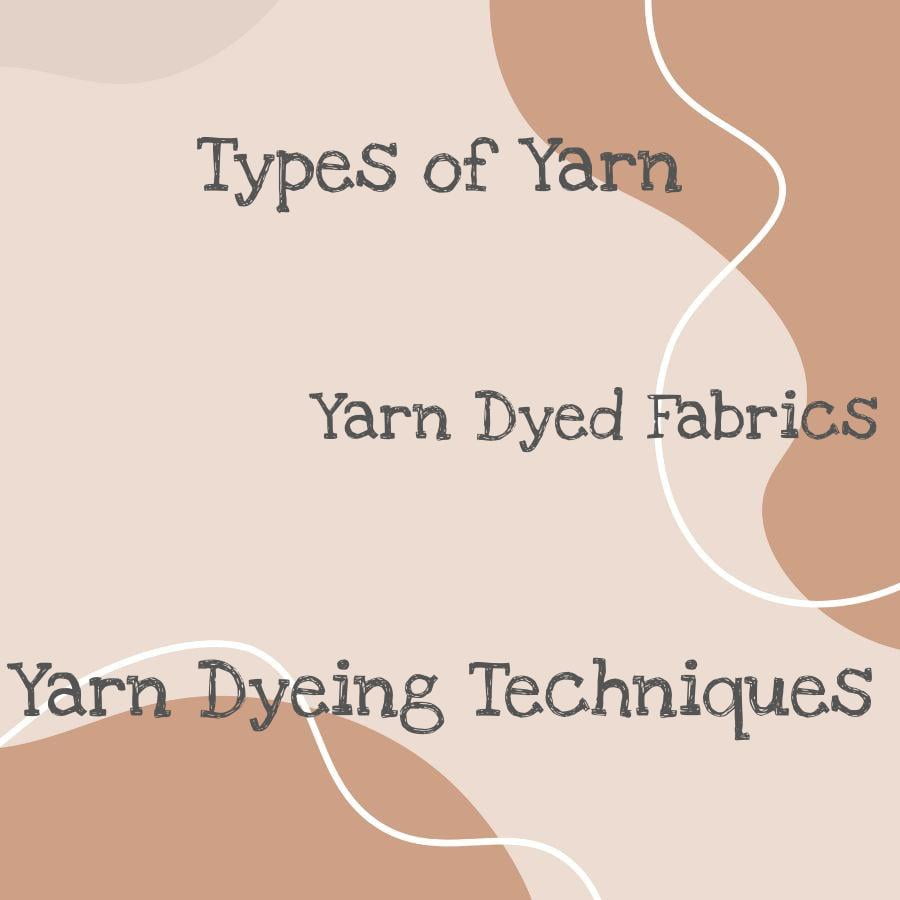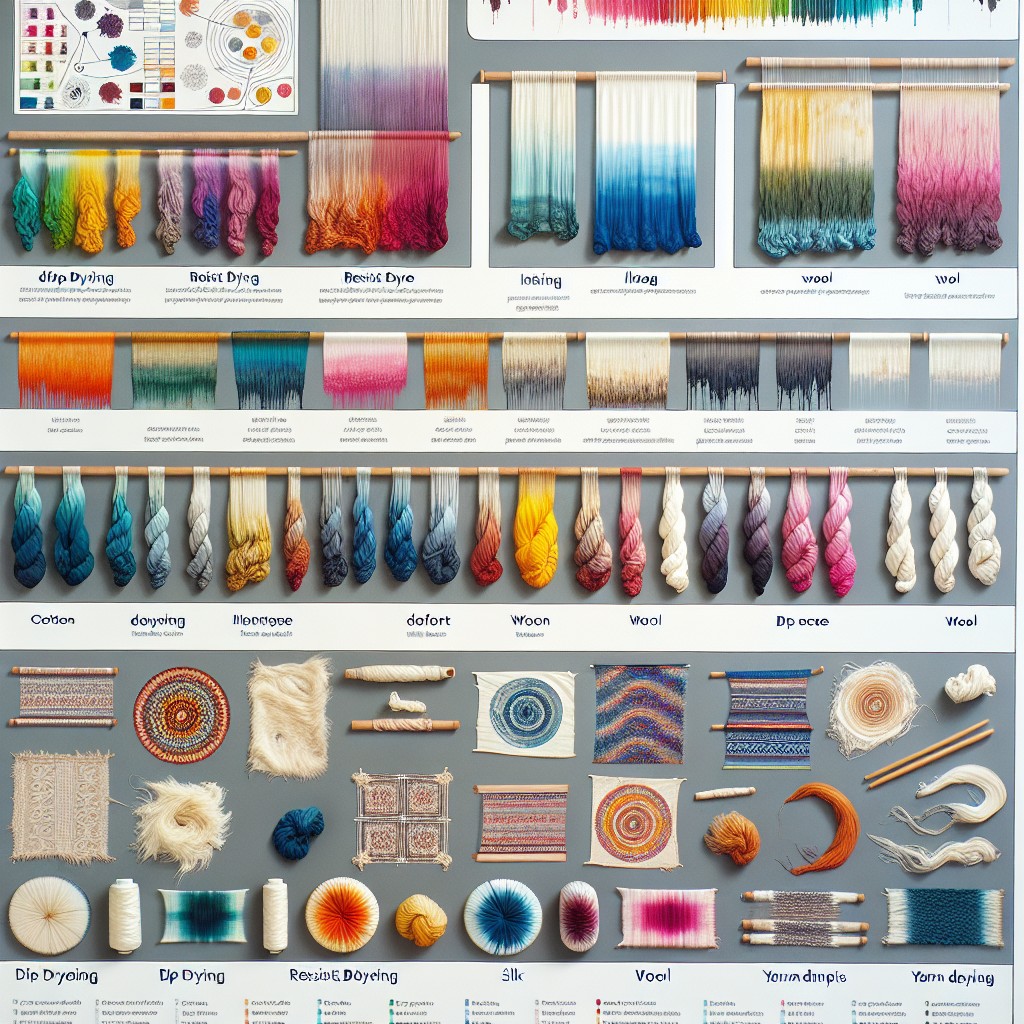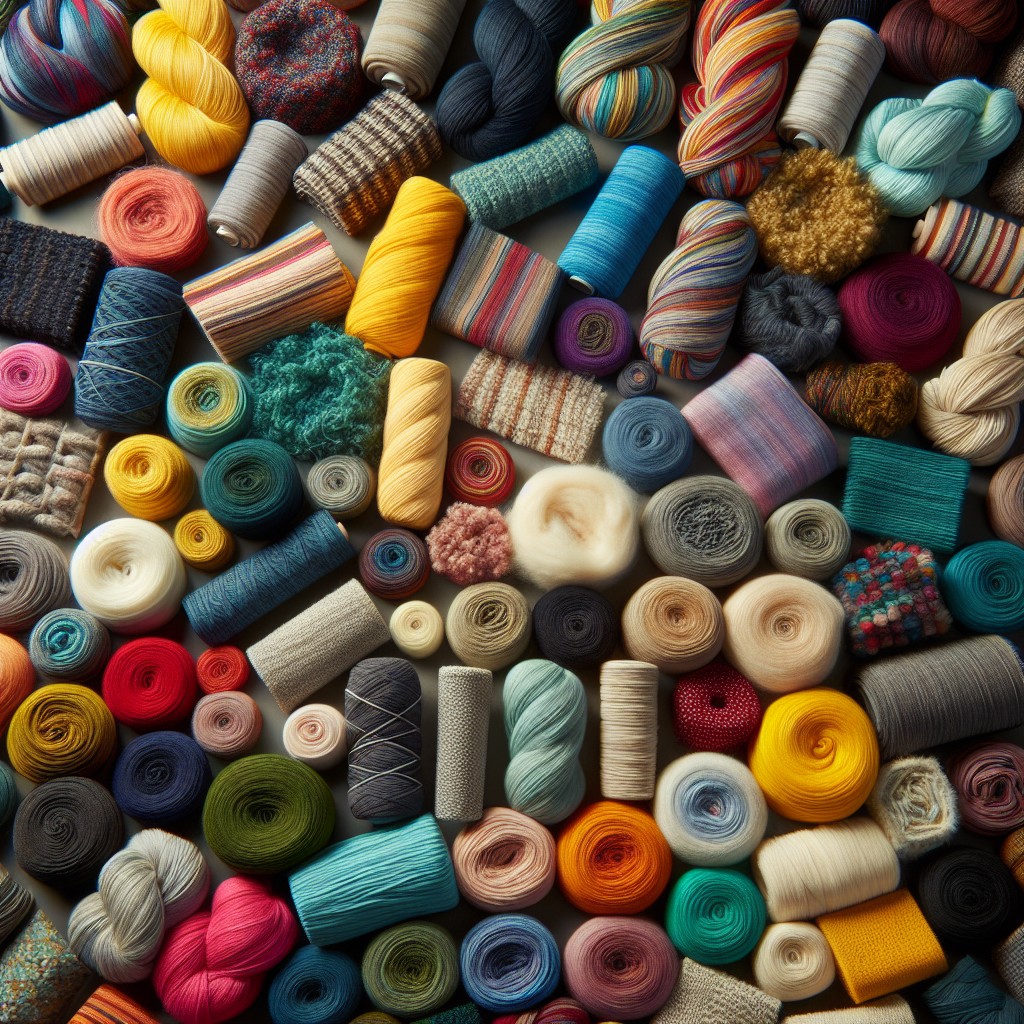Discover the fascinating world of yarn-dyed fabrics as we unravel the various types and their unique characteristics in this informative blog post.
Are you a yarn enthusiast who loves to experiment with different types of fabrics? If yes, then you must have heard about yarn-dyed fabrics. These fabrics are gaining popularity among crafters and fashion designers alike, thanks to their unique and vibrant designs.
Yarn-dyed fabric is created by weaving together threads that have been dyed before being woven into the fabric. This results in a beautiful pattern that is visible on both sides of the material, making it perfect for creating eye-catching garments or home decor items.
In this blog post, we’ll explore some of the most popular types of yarn-dyed fabrics and how they can be used in your next project. So grab your knitting needles or crochet hooks and let’s dive into the colorful world of yarn-dyed fabric!
Introduction to Yarn Dyed Fabrics

Yarn-dyed fabrics are a popular choice for many crafters and designers due to their unique characteristics. Unlike printed or solid-colored fabrics, yarn-dyed materials are created by weaving together threads that have been dyed before being woven into the fabric.
This results in a beautiful pattern that is visible on both sides of the material, making it perfect for creating eye-catching garments or home decor items.
One of the most significant advantages of yarn-dyed fabrics is their durability. Since each thread has been individually dyed before being woven into the fabric, they tend to hold up better over time than printed or piece-dyed materials.
Because each thread is colored separately, there’s less chance of fading or bleeding during washing.
Another advantage of using yarn-dyed fabrics in your projects is their versatility when it comes to design options. With so many different types and colors available on today’s market – from classic stripes and plaids to intricate jacquard weaves – you’re sure to find something that suits your style preferences perfectly.
Yarn Dyeing Techniques

There are several techniques used in yarn dyeing, each with its unique characteristics and advantages. One of the most popular methods is skein dyeing, where the yarn is wound into a loose coil or hank and then immersed in a dyebath.
This technique allows for even color distribution throughout the entire length of the thread.
Another common method is space-dyeing, which involves applying different colors to specific sections of the yarn to create variegated patterns when woven together. In contrast, dip-dyeing involves partially immersing one end of an already-woven fabric piece into a dyebath to create an ombre effect.
Some other techniques include hand-painting (where dyes are applied by hand onto individual threads), resist-dye (using wax or other materials to prevent certain areas from being colored), and tie-dye (tying off sections with string before dipping them in various colors).
Advantages of Yarn Dyed Fabrics

One significant advantage is that the colors in yarn-dyed fabric are more vibrant and long-lasting than those in piece-dyed or printed fabrics. This is because the dye penetrates deep into each thread, resulting in a colorfast material that won’t fade easily.
Another benefit of yarn-dyed fabric is its versatility. It can be used for a wide range of projects, from clothing to home decor items like curtains and tablecloths.
The unique patterns created by weaving together different colored threads make it an excellent choice for creating eye-catching designs.
Yarn dyed-fabrics tend to have better texture and feel compared to other types of materials since they are made up entirely of dyed threads woven together rather than having prints on top or being dipped into dyes after being woven.
Lastly, using yarns with natural fibers such as cotton or linen makes them eco-friendly as these fibers biodegrade naturally without causing harm to the environment unlike synthetic ones which take years before decomposing completely.
Common Yarn Dyed Fabric Types

Some of the most popular ones include:.
1. Chambray: This lightweight fabric is made from cotton or linen and has a plain weave with colored warp threads and white weft threads.
2. Gingham: A classic checkered pattern that features even-sized squares in two different colors, usually white and another color.
3. Madras: A lightweight cotton fabric that comes in bright colors with plaid or striped patterns.
4. Seersucker: This puckered fabric is perfect for summer clothing due to its lightness, breathability, and ability to resist wrinkles.
5. Tartan/Plaid: These fabrics feature crisscrossing horizontal and vertical stripes in multiple colors on a solid background color.
Applications of Yarn Dyed Fabrics

They are perfect for creating unique garments, home decor items, and accessories that stand out from the crowd. One popular application of yarn-dyed fabrics is in quilting.
Quilters love to use these types of fabrics because they add depth and texture to their projects.
Another common use for yarn-dyed fabric is in fashion design. Designers often incorporate these materials into their collections because they offer endless possibilities when it comes to color combinations and patterns.
Home decorators also appreciate the beauty of yarn-dyed fabric as it adds an extra layer of sophistication to any room’s decor with its rich colors, textures, or patterns on display through curtains or upholstery.
Moreover, Yarn dyed cottons make excellent shirts while woolen ones work well as jackets or coats due to their durability.
Yarn Dyed Versus Piece Dyed Fabrics
As we’ve already discussed, yarn-dyed fabric is created by weaving together threads that have been dyed before being woven into the fabric. On the other hand, piece-dyed fabrics are made from undyed cloth that is cut into pieces and then dyed in a vat or with a printing process.
One of the biggest advantages of using yarn-dyed fabrics over piece-dyeds is their colorfastness. Since each individual thread has been dyded prior to weaving, this ensures that colors remain vibrant even after multiple washes or exposure to sunlight.
Another advantage of using yarns for dyeing instead of pre-cut pieces lies in its versatility when creating patterns on textiles; since each thread can be individually colored before being woven together with others (as opposed to having an entire section printed at once), designers have more control over how they want their final product’s pattern/design layout will look like.
Caring for Yarn Dyed Fabrics
However, to maintain the beauty of these fabrics, it is essential to take proper care of them. Here are some tips on how to care for your yarn-dyed fabric:
1. Always read the care label: The first step in caring for any fabric is reading its care label instructions carefully.
2. Wash with similar colors: To prevent color bleeding or fading, always wash your yarn-dyed fabric with similar colored items.
3. Use a gentle detergent: Harsh detergents can damage the fibers and cause discoloration over time; therefore, use a mild detergent while washing.
4. Avoid high heat settings: High temperatures can shrink or damage yarn dyed fabrics; hence it’s best to avoid hot water and high-heat dryer settings when laundering them.
5.Store properly : Store your finished projects made from yarn dyed fabrics in cool dry places away from direct sunlight as exposure may lead to fading over time.
Yarn Dyed Fabrics in Fashion
From classic stripes to intricate plaids, designers use yarn-dyed fabrics to create unique and eye-catching garments that stand out from the crowd. Yarn-dyed fabrics are versatile and can be used in a variety of clothing items such as dresses, shirts, skirts, pants or jackets.
One of the most significant advantages of using yarn-dyed fabric is its ability to hold color well over time. This means that even after multiple washes or exposure to sunlight; your garment will still look vibrant and fresh.
Another reason why designers love working with yarn dyed fabric is because it allows them more creative freedom when designing their collections. With an endless array of colors and patterns available at their fingertips, they can create truly one-of-a-kind pieces that reflect their unique style.
Sustainable Yarn Dyeing Practices
The textile industry is one of the largest polluters globally, and yarn dyeing contributes significantly to this pollution. However, there are ways we can reduce our impact on the environment while still enjoying beautiful yarn-dyed fabrics.
One way is by using natural dyes instead of synthetic ones that contain harmful chemicals. Natural dyes come from plants such as indigo or madder root and do not harm the environment when disposed of correctly.
Another sustainable practice is reducing water usage during dyeing processes through innovative technologies like air dyeing or cold-water reactive dyes that require less water than traditional methods.
Recycling wastewater from dyehouses can help reduce pollution levels in nearby rivers and streams while conserving resources at the same time.
Yarn Dyed Fabric Defects
These defects can occur during the dyeing process or weaving process and may not always be visible to the naked eye. Some common yarn dyed fabric defects include color bleeding, uneven dyeing, broken threads or knots in the weave, and snags.
Color bleeding occurs when excess dye is present on a fabric that has not been properly rinsed after being dyed. This defect causes colors to bleed into each other resulting in an undesirable look.
Uneven dyeing happens when some areas of a fabric absorb more color than others due to inconsistencies in the dying process.
Broken threads or knots in weaves are caused by weak spots within individual fibers which break under tension while weaving causing holes within woven fabrics.
Snags happen when loose fibers get caught on sharp objects like jewelry leading them out of place from where they were originally woven into creating unsightly pulls across your garment’s surface area.
How to Choose the Right Yarn Dyed Fabric
First and foremost, think about the purpose of your creation. Are you making a garment or home decor item? The type of yarn-dyed fabric that works best for one may not be suitable for another.
Next, consider the weight and texture of the material. Yarn dyed fabrics come in various weights ranging from lightweight to heavy-duty materials like denim or canvas.
If you’re creating something that requires structure like bags or upholstery items, then heavier-weight fabrics would be ideal.
Another factor to keep in mind is colorfastness – how well will it hold up after washing? Some dyes fade faster than others when exposed to sunlight or water; therefore, choose high-quality yarns with good color retention properties if longevity is important.
Lastly but equally important is cost-effectiveness- some types of yarn dyed fabrics can be more expensive than others due to their quality and production process involved in dyeing them before weaving into cloth.
Yarn Dyed Fabric Trends
The fashion industry is always on the lookout for new and exciting ways to incorporate yarn-dyed fabrics into their collections. One of the latest trends in yarn-dyed fabric is using bold colors and patterns to create eye-catching designs that stand out from the crowd.
Another trend that has emerged recently is combining different types of yarns to create unique textures and finishes. For example, mixing cotton with silk or wool can result in a luxurious fabric with a soft feel and beautiful drape.
Sustainability has also become an important consideration when it comes to choosing materials for clothing production. Yarn dyers are now experimenting with natural dyes made from plants such as indigo, madder root, or cochineal insects instead of synthetic chemicals.
Expanding the List With Relevant Headings From the Given List
In addition to the main headings listed above, there are several other areas worth exploring in more detail. For example, if you’re new to yarn dyeing and textiles in general, a comprehensive guide with pictures can be incredibly helpful for understanding different types of fibers and how they’re used in fabric production.
If you’re looking for specific examples of high-quality yarn dyed fabrics on the market today, then Essex Linen/Cotton or Kitchen Window Wovens Yarn Dyed Cotton Fabrics might pique your interest. These materials offer unique textures and patterns that can add depth and character to any project.
For those interested in sustainable textile practices or designer deadstock options like Yarn Dyed Linen Fabrics may be an excellent choice as well.
How to Easily Identify Yarn Dyed Fabrics
But how can you easily identify yarn-dyed fabrics? One way to do this is by looking at the fabric’s pattern on both sides. Yarn-dyed fabrics have a visible pattern on both sides of the material, unlike printed or piece-dyed fabrics that only have one side with a design.
Another way to identify yarn dyed-fabrics is by examining the edges of the fabric. If you notice that each thread has its own color before being woven together, then it’s likely that you’re dealing with yarn dyed-fabric.
It’s important to note that some manufacturers may use terms like “dyed” or “printed” interchangeably when describing their products. So if in doubt, don’t hesitate to ask for clarification from your supplier or retailer.
Yarns in Textiles: A Complete Guide With Pictures
That’s why understanding different types of yarns is essential for any crafter or designer working with these fabrics. In this section, we’ll take a closer look at various types of yarns commonly used in textiles.
Cotton Yarn: Cotton is one of the most popular fibers used for making textile products due to its softness and breathability. It can be spun into different weights and textures, making it versatile enough for use in various applications.
Wool Yarn: Wool is another widely-used fiber that has excellent insulating properties while being lightweight. It can be spun into fine or thick threads depending on its intended use.
Silk Yarn: Silk has been prized as a luxury fabric since ancient times due to its lustrous sheen and smooth texture. Its strength makes it ideal for creating delicate yet durable garments like scarves or blouses.
Linen Yarn: Linen fibers are derived from flax plants’ stems, resulting in strong yet breathable fabric that becomes softer with each wash cycle. Blended Yarns: Blending two or more fibers together creates blended yarns that combine their unique characteristics such as durability (wool) with softness (cotton).
Essex – Linen/Cotton – Yarn Dyed Fabrics
This fabric is a combination of 55% linen and 45% cotton, making it perfect for creating lightweight garments or home decor items. The unique texture and feel of this fabric make it stand out from other types of yarn-dyed materials.
Essex linen/cotton blend comes in a variety of colors, ranging from soft pastels to bold hues that can add an extra pop to your project. Its versatility makes it ideal for various applications such as quilting, dressmaking, bag-making or even upholstery.
If you’re looking for inspiration on how to use Essex linen/cotton blend in your next project, consider using them as accent pieces on larger projects like blankets or tablecloths. You could also create beautiful summer dresses with its breathable quality that will keep you cool during hot weather.
Kitchen Window Wovens – Yarn Dyed Cotton Fabrics
These fabrics are known for their durability, softness, and unique designs. Kitchen Window Wovens offers a wide range of colors and patterns to choose from, making it easy to find the perfect fabric for your next project.
One of the most significant advantages of using Kitchen Window Woven’s yarn-dyed cotton fabrics is their versatility. They can be used in various applications such as quilting, home decor items like curtains or tablecloths, clothing items like shirts or dresses – you name it! The possibilities are endless with these beautiful textiles.
Another advantage is that they hold up well over time due to being made from 100% pure cotton fibers which makes them machine washable without losing color intensity or shape retention.
If you’re looking for high-quality yarn-dyed cotton fabric with unique designs and excellent durability properties then look no further than Kitchen Window Wovens!.
Designer Deadstock – Yarn Dyed Linen Fabrics
This company specializes in sourcing deadstock designer fabrics from around the world, including yarn-dyed linens. Their collection of yarn-dyed linen fabrics features a range of colors and patterns that are sure to inspire your next project.
One advantage of using Designer Deadstock’s yarn dyed linens is their sustainability factor. By utilizing deadstocks (leftover fabric rolls from fashion houses), they reduce waste while providing customers with one-of-a-kind materials that cannot be found anywhere else.
Yarn dyed linen fabric has a natural texture that adds depth and character to any garment or home decor item it’s used for. It also drapes beautifully, making it ideal for creating flowy dresses or curtains.
FAQ
What are the examples of dyed fabric?
Examples of dyed fabric include stripes, checks, plaids, gingham, dotted or cross patterns, Dobby type weaving process, and denim.
What are the different types of dyed fabric?
Different types of dyed fabric include acrylic fibers with basic dyes, nylon and protein fibers like wool and silk with acid dyes, polyester yarn with disperse dyes, and cotton with vat dyes, reactive dyes, and direct dyes.
What are yarn dyed fabric swatches called?
Yarn-dyed fabric swatches are called handlooms.
What is the difference between yarn dyed and piece dyed fabric?
The difference between yarn dyed and piece dyed fabric is that yarn dyed fabric has yarns dyed before weaving or knitting, as seen in checks, stripes, and denim, while piece dyed fabric is dyed after the fabric is made using grey yarns.
What are the various dyeing techniques used in creating yarn dyed fabrics?
Various dyeing techniques used in creating yarn dyed fabrics include space dyeing, hank dyeing, skein dyeing, package dyeing, and cheese dyeing.
How does the quality and durability of yarn dyed fabrics compare to other dyeing methods?
Yarn dyed fabrics typically offer higher quality and durability compared to other dyeing methods, as the color penetrates deeper into the fibers, resulting in enhanced colorfastness and resistance to fading.
Which applications and products are best suited for yarn dyed fabrics?
Yarn dyed fabrics are best suited for applications and products such as upholstery, curtains, clothing, and bed linens.
